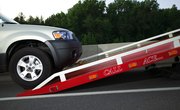A secured loan is backed by collateral, such as a home or vehicle. If you fall behind on your payments or otherwise fail to meet the obligations you agreed to in the loan contract -- such as maintaining homeowners insurance for your property, for example -- your loan can go into default. When you default on your secured loan, you risk losing your collateral. Your lender's likely course of action depends on the type of loan and the value of the collateral.
Getting Out of Default
Your default period depends on your loan agreement. If your contract doesn't state a specific amount of time, missing even one payment may constitute default. Maintaining your property rights will require you to work with your lender to either pay the overdue amount in a lump sum or make alternative payment arrangements. Doing so can slow the lender's move to repossess your property, since it's an indication that you're willing to pay your balance.
In addition, while loans can go into default with a month, many states don't allow repossession to take place quite so quickly. Some require creditors to provide notice of your right to cure the default. This gives you a certain amount of time to make up the past-due payments and late charges or remedy the situation causing you to be in default.
Impact of a Default
Defaulting on a secured loan has a negative impact on your credit score, which hampers your ability to borrow money in the future. The specific impact depends on the nature of the default and what the lender does next. For example, if your loan goes into default after 30 days, the notation of a late payment on your credit report will lower your score. If the delinquency is longer, or if a foreclosure or credit judgement is entered against you, the impact is far more severe.
A default also may cause the lender to repossess the property, though it can pursue other options instead. For example, if you default on a home equity loan, the lender likely will not foreclose because it has a junior position on the property and only will be paid after the primary mortgage is satisfied. Instead, it may choose to place a lien on the property, preventing you from selling it until the debt is satisfied.
Tips
Even in Chapter 7 bankruptcy, your lender usually can win the right to repossess the collateral if you aren't current on your payments. Though your bankruptcy filing automatically places a stay on repossession or foreclosure proceedings, the creditor can ask the court to lift the stay, and if you're not current on your payments this usually will be granted.
When You're Under Water
Losing the asset held by a secured loan isn't always entirely bad for the borrower. For example, if your home is significantly under water, meaning you owe much more than the home is worth, a default and foreclosure can get you out of a onerous obligation that's unlikely to be worth the money anytime soon. However, this may not serve your purposes depending on the type of loan and your state law. In some states, even if you surrender the defaulted property, the lender can pursue collections action against you for the difference between what you owe and what the property can be sold for. Check with your lender and your state law before surrendering property in default, and get an agreement with the lender in writing that confirms your surrender of the property fulfills your obligations under the loan and you won't be charged for any remaining balance.
References
- Federal Trade Commission. "Making Payments to Your Mortgage Servicer." Accessed July 13, 2020.
- Federal Student Aid. "Student Loan Delinquency and Default." Accessed July 13, 2020.
- Experian. "What Happens If I Default on a Loan?" Accessed July 13, 2020.
- Experian. "What Happens If I Stop Paying My Credit Cards?" Accessed July 13, 2020.
- Federal Trade Commission. "Trouble Paying Your Mortgage?" Accessed July 13, 2020.
- Consumer Financial Protection Bureau. "Learn About Mortgage Relief Options and Protections." Accessed July 13, 2020.
- Federal Student Aid. "Coronavirus and Forbearance Info for Students, Borrowers, and Parents." Accessed July 13, 2020.
- Federal Student Aid. "Getting Out of Default." Accessed July 13, 2020.

